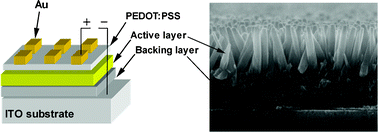Hybrid polymer/metal oxide solar cells based on ZnO columnar structures†
Abstract
We focus on the preparation of hybrid

* Corresponding authors
a
Centre for Electronic Materials and Devices, Department of Chemistry, Exhibition Road, London, UK
E-mail:
a.peiro@ic.ac.uk
Fax: +(44) (0)20 7594 5801
b Centre for Electronic Materials and Devices, Department of Physics, Exhibition Road, London, UK
c Department of Physics, University of Jaffna, Sri Lanka
d The Manchester Materials Science Centre and Department of Chemistry, Oxford Road, Manchester, UK
We focus on the preparation of hybrid

 Please wait while we load your content...
Something went wrong. Try again?
Please wait while we load your content...
Something went wrong. Try again?
A. M. Peiró, P. Ravirajan, K. Govender, D. S. Boyle, P. O'Brien, D. D. C. Bradley, J. Nelson and J. R. Durrant, J. Mater. Chem., 2006, 16, 2088 DOI: 10.1039/B602084D
To request permission to reproduce material from this article, please go to the Copyright Clearance Center request page.
If you are an author contributing to an RSC publication, you do not need to request permission provided correct acknowledgement is given.
If you are the author of this article, you do not need to request permission to reproduce figures and diagrams provided correct acknowledgement is given. If you want to reproduce the whole article in a third-party publication (excluding your thesis/dissertation for which permission is not required) please go to the Copyright Clearance Center request page.
Read more about how to correctly acknowledge RSC content.
 Fetching data from CrossRef.
Fetching data from CrossRef.
This may take some time to load.
Loading related content
